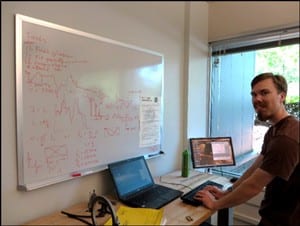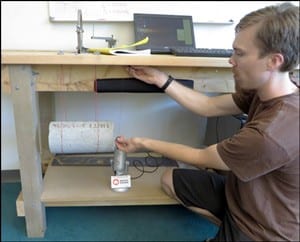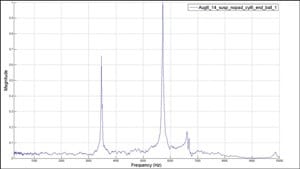In the Haiti earthquake in 2010, extensive damage to infrastructure resulted from the extremely poor quality of the concrete masonry blocks of which it was primarily composed. Since the primary method of testing the compressive strength of concrete is to measure the force required to crush a sample, which requires specialized and expensive equipment, it is economically impossible for the many small block manufacturers in developing countries to test their blocks in this way. To address this issue, several Instructors from BCIT (Neil Cox, Diane Kennedy, and Glenn Pellegrin from the BCIT EE Department, Svetlana Brzev from the BCIT Civil Engineering Department, and James Booth from the BCIT Physics Department) began looking into finding a non-destructive method of determining the strength of concrete blocks. This would be substantially less expensive, hopefully making it economically feasible for the block manufacturers, while also leaving the tested block intact.
An idea was initially suggested by Bill McEwen, Executive Director of the Masonry Institute of British Columbia; masons judge the approximate strength of masonry bricks by simply clinking two of them together and checking that they ‘sound right’. Thus, we are currently investigating the acoustic characteristics of concrete blocks and cylinders to determine if it is possible to accurately gauge the compressive strength of a concrete sample by striking it with some sort of tool and analyzing the sound it produces.
In the summer of 2013, Prem Chane and Hedaya Sheroz, both Civil Engineering students at BCIT, worked on producing a library of concrete blocks and cylinders of various strengths using a block mold procured from Haiti. They performed standard destructive tests on half of the blocks and cylinders in order to determine the mechanical properties such as strength and modulus of elasticity as a reference for further non-destructive testing and analysis.
 This summer, I concentrated primarily on the concrete cylinders, as these are simple in shape and should have a less complex acoustic signature than the blocks. Our goal was to try to determine the speed of sound in our concrete samples and to try to measure its relationship to the specimen strength. If we apply an impulse to an object, that object will vibrate at its particular resonant frequency, which is determined by the speed of sound through the object as well as its shape. We expect these resonant frequencies to be correlated to the compressive strength of the samples. This correlation is what we hope to obtain from the concrete cylinders.
This summer, I concentrated primarily on the concrete cylinders, as these are simple in shape and should have a less complex acoustic signature than the blocks. Our goal was to try to determine the speed of sound in our concrete samples and to try to measure its relationship to the specimen strength. If we apply an impulse to an object, that object will vibrate at its particular resonant frequency, which is determined by the speed of sound through the object as well as its shape. We expect these resonant frequencies to be correlated to the compressive strength of the samples. This correlation is what we hope to obtain from the concrete cylinders.
 At the beginning of the project, we looked at the ASTM C215-02 Standard for longitudinal resonance testing to determine the best method of recording data. The specifications are rather vague and so our first attempt at creating a holder for the cylinders created substantial damping of most of the important frequencies. At the suggestion of Scott Jackson from the UBC Department of Civil Engineering, we suspended the cylinders with wire, thus allowing free vibration in the longitudinal direction. This method worked very well for the size of samples I was working with; however for larger samples, the issue of weight would make it unsuitable. In those cases, we determined that a simple pad of thick rubber on the floor worked very nearly as well as did suspension. Upon further examination of the ASTM standard, it appears this padding method is more similar to what was intended.
At the beginning of the project, we looked at the ASTM C215-02 Standard for longitudinal resonance testing to determine the best method of recording data. The specifications are rather vague and so our first attempt at creating a holder for the cylinders created substantial damping of most of the important frequencies. At the suggestion of Scott Jackson from the UBC Department of Civil Engineering, we suspended the cylinders with wire, thus allowing free vibration in the longitudinal direction. This method worked very well for the size of samples I was working with; however for larger samples, the issue of weight would make it unsuitable. In those cases, we determined that a simple pad of thick rubber on the floor worked very nearly as well as did suspension. Upon further examination of the ASTM standard, it appears this padding method is more similar to what was intended.
We also tried a number of different striking implements; however, most of the tools we used had substantial resonant frequencies of their own that muddied the acoustic signals. For example, when we used a hammer to strike the cylinder, our recorded sound contained both the cylinder resonance and the hammer resonance. We determined that using a metal sphere to strike the specimens produced the clearest acoustic signatures. This is also suggested in the ASTM standard, although the size of sphere we used was substantially larger than what the standard specifies, partly because that was what was available, and partly because we required the extra mass to give us a sufficiently strong acoustic signal from the cylinders.
We found that the acoustic signals from the concrete cylinders were often characterized by three distinct peaks in the frequency spectrum of a cylinder, as illustrated in Figure 1. These frequencies are associated with different types of vibrational modes in the cylinders. The lowest frequency peak appears to best match the theoretically predicted speed of sound in the sample calculated using the modulus of elasticity. The clarity of these peaks varies from cylinder to cylinder, but the lowest one especially seems quite consistent.

Figure 2: Spectra of Strong (Pink) and Weak (Blue) Cylinders, Note Lower Frequency Peaks for Weaker Cylinder.
This project provided me the opportunity to apply some of the skills I have developed through my training in Electrical Engineering at BCIT. In particular, I was required to design and build an experimental setup, apply some programming techniques in the analysis of the data to interpret and clarify the results, and make use of my technical writing skills. This work has helped to advance this project substantially towards the goal of creating a non-destructive concrete block strength indicator.
I was honoured to be the recipient of the Natural Sciences and Engineering Council of Canada (NSERC) Undergraduate Student Research Award (USRA) for this project. I would also like to thank Jim Booth for his supervision and direction, as well as Svetlana Brzev, Neil Cox, Glenn Pellegrin, and Diane Kennedy, for their help and advice. I would also like to thank Nancy Paris and the BCIT PART group for supporting this project.

This work was funded by NSERC and the BCIT VP Research Fund.
By Joel Hooge, BCIT EE Student
